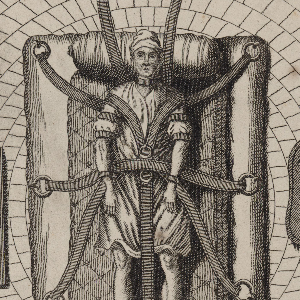Culture

Louis XVI distributes aid to the Poor
Here Louis XVI is portrayed as a benevolent king distributing alms to the poor, an appropriate action for the "Father of his people." However, his rich fur–clad outfit contrasts with the abject poverty of the common people, suggesting to those inclined to be critical that the King did not underst

Removal of the Parlements
The French Revolutionary engraving's depiction of the physical eviction of the black–robed magistrates in front of a female audience has a somewhat ambiguous message.

Damiens Being Broken on the Wheel
This straightforward representation of Damiens gives no hint of sympathy for a would–be pre-revolutionary royal assassin.
The Coronation of Louis XVI from the Gazette of France (1775)
These two articles from the official newspaper of the day describe the coronation of Louis XVI at Reims, the city to which French kings had traveled to be anointed and crowned for a thousand years.
Moreau, "On the Origins of the French Monarchy"
Jacob–Nicolas Moreau wrote this excerpt as part of his Lessons of Morality, Politics and Law (1773) at the request of the aging Louis XV for the instruction of the Dauphin. Throughout the 200–page book, Moreau defends the power of the King to rule France without opposition.
Bossuet, "The Nature and Properties of Royal Authority"
Jacques–Benigne Bossuet (1627—1704), bishop of Meaux, was a well–known seventeenth–century peacher who believed that although France had a sizable minority of Protestants, France should have a single religion, Catholicism.
Short Teaching Module: Modern Racism in the U.S. and South Africa
This module has students examine the roots of “modern” racism and make connections between the status of Black individuals in the United States and in South Africa. This approach is designed to foster a discussion on American “exceptionalism,” in particular that U.S.
Letter from a Birmingham Jail
Martin Luther King Jr. wrote his "Letter from a Birmingham Jail" on April 16, 1963 as a response to a letter titled "A Call for Unity" which was written 4 days prior. "A Call for Unity" was signed by eight white clergymen who led churches in Birmingham, Alabama.
Short Teaching Module: Women in Classical Athens and Sparta
Primary texts about women in classical Athens and Sparta provide an excellent, if extreme, example of one of the main themes in the 100-level “World History to 1500.” This theme is the relationship between social structure and political institutions.
Moralia
Part of Plutarch's Moralia, these sayings by Spartan women demonstrate not only the martial culture of Sparta that emphasized physical courage and honor, but also the role of women in reinforcing that culture.